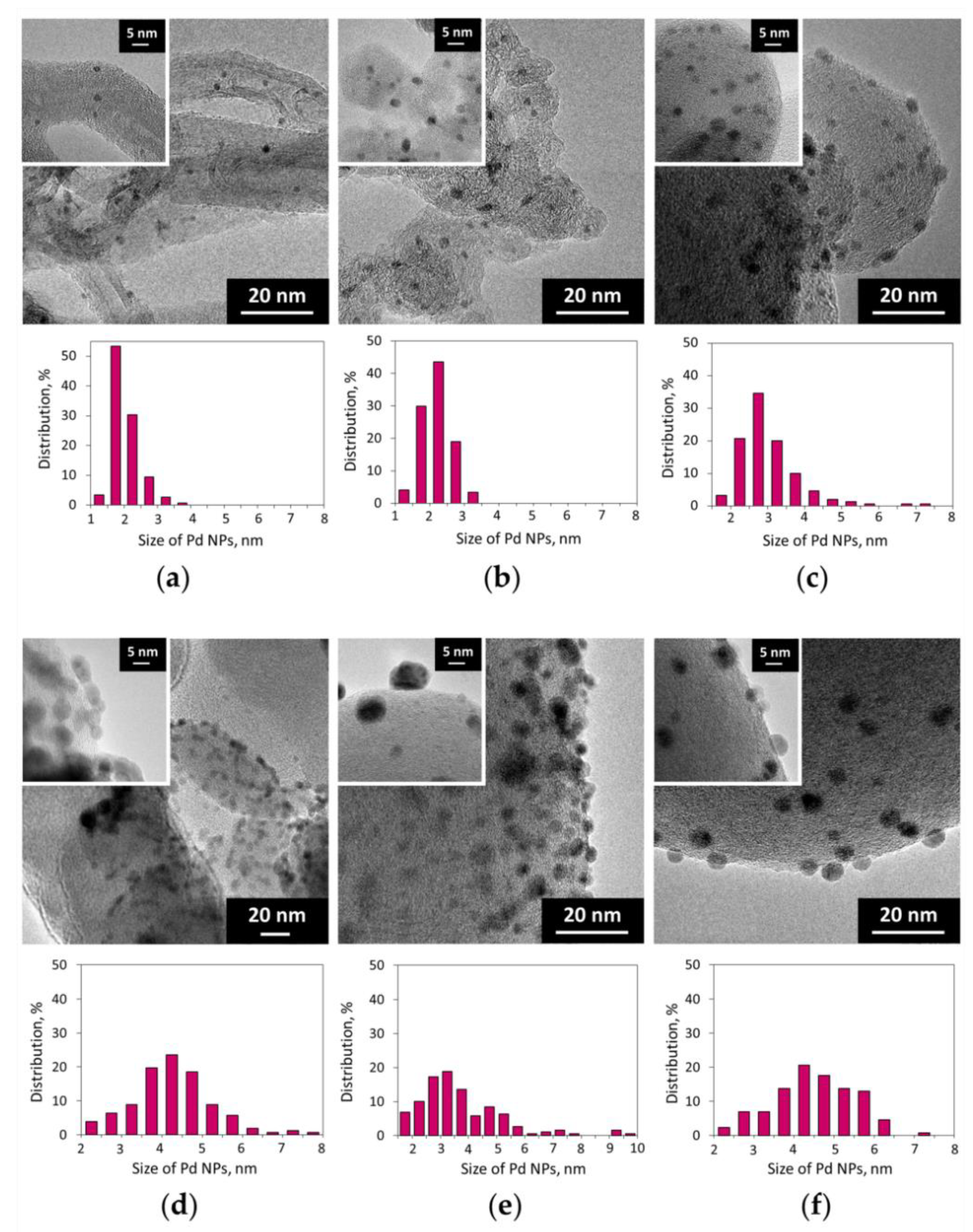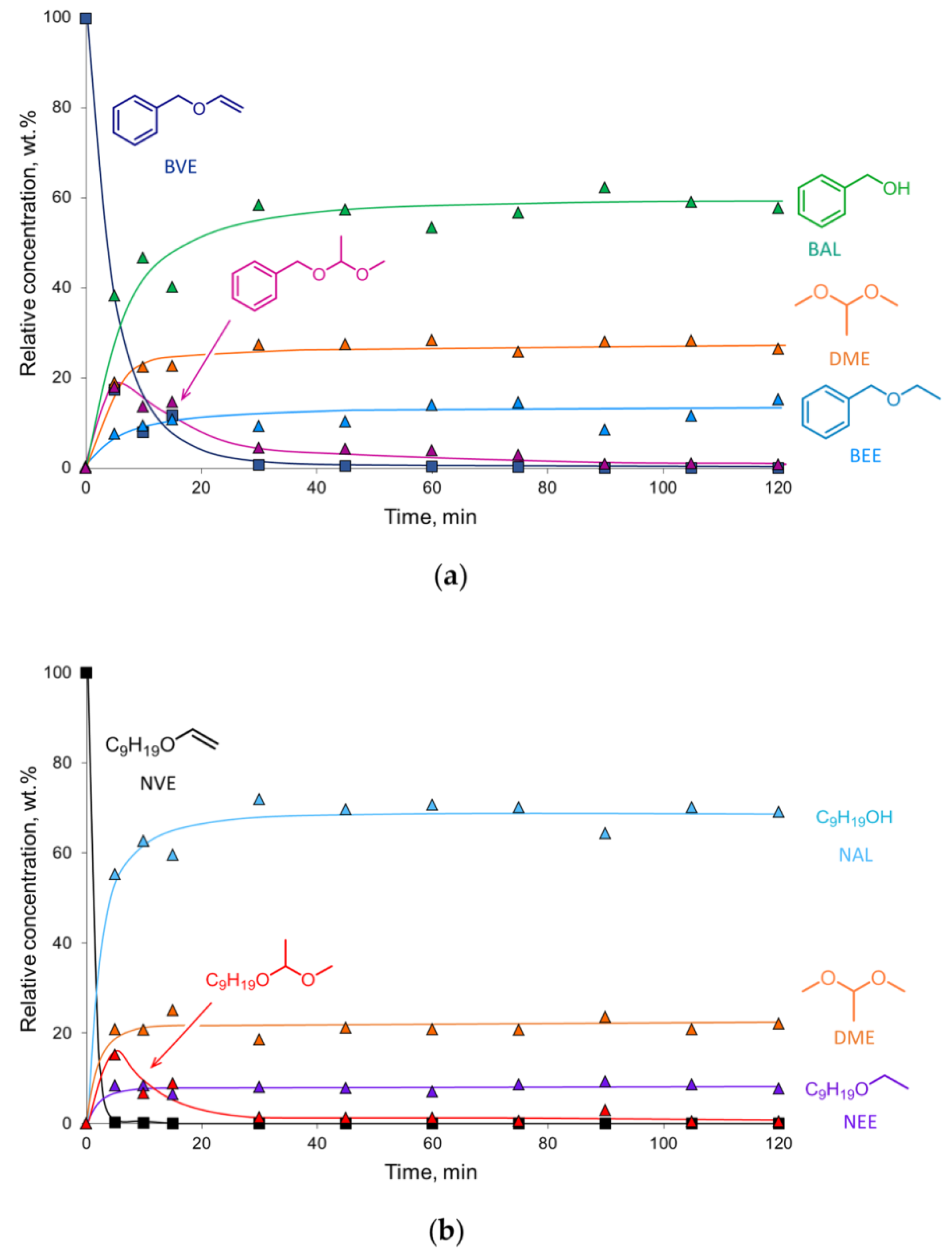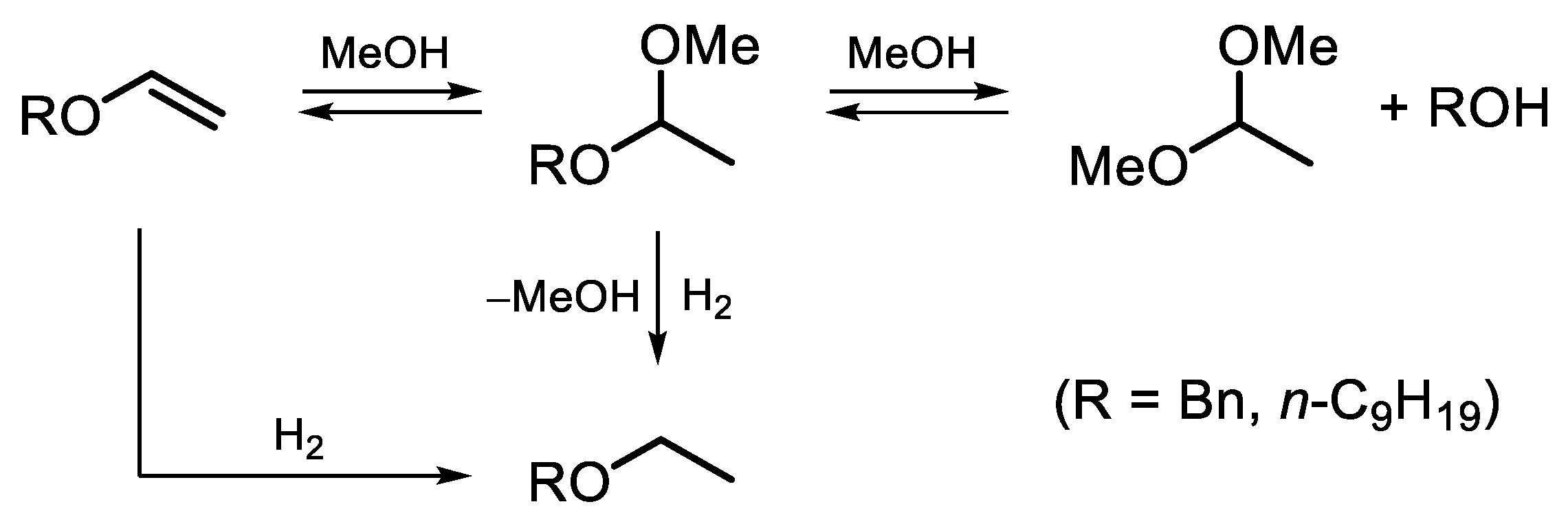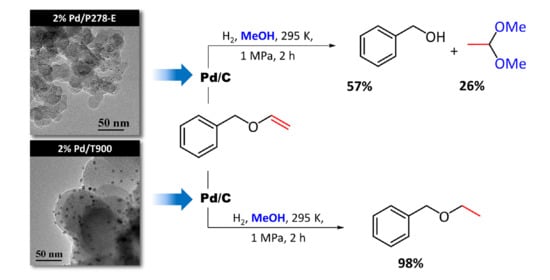Sustainable Hydrogenation of Vinyl Derivatives Using Pd/C Catalysts
Abstract
:1. Introduction
2. Results and Discussion
2.1. Characterization of Catalysts
2.2. Effect of Carbon Support on the Activity and Selectivity of Pd/C Catalysts in the Hydrogenation of Vinyl Derivatives
2.3. Effect of the Palladium Precursor Used for the Preparation of Pd/C Catalysts on Their Activity and Selectivity in the Hydrogenation of Vinyl Derivatives
3. Materials and Methods
3.1. Materials and Reagents
3.2. Catalyst Preparation and Characterization
3.3. Hydrogenation of Vinyl Derivatives and Analysis of Reaction Products
4. Conclusions
Supplementary Materials
Author Contributions
Funding
Data Availability Statement
Acknowledgments
Conflicts of Interest
References
- Zimmerman, J.B.; Anastas, P.T.; Erythropel, H.C.; Leitner, W. Designing for a green chemistry future. Science 2020, 367, 397–400. [Google Scholar] [CrossRef] [PubMed]
- Sheldon, R.A. Green and sustainable manufacture of chemicals from biomass: State of the art. Green Chem. 2014, 16, 950–963. [Google Scholar] [CrossRef]
- Sheldon, R.A. Engineering a more sustainable world through catalysis and green chemistry. J. R. Soc. Interface 2016, 13, 20160087. [Google Scholar] [CrossRef] [PubMed] [Green Version]
- Trost, B.M. The atom economy—A search for synthetic efficiency. Science 1991, 254, 1471–1477. [Google Scholar] [CrossRef] [PubMed]
- Trost, B.M. On Inventing Reactions for Atom Economy. Acc. Chem. Res. 2002, 35, 695–705. [Google Scholar] [CrossRef]
- Ragauskas, A.J.; Williams, C.K.; Davison, B.H.; Britovsek, G.; Cairney, J.; Eckert, C.A.; Frederick, W.J.; Hallett, J.P.; Leak, D.J.; Liotta, C.L.; et al. The Path Forward for Biofuels and Biomaterials. Science 2006, 311, 484–489. [Google Scholar] [CrossRef] [Green Version]
- Himmel, M.E.; Ding, S.-Y.; Johnson, D.K.; Adney, W.S.; Nimlos, M.R.; Brady, J.W.; Foust, T.D. Biomass Recalcitrance: Engineering Plants and Enzymes for Biofuels Production. Science 2007, 315, 804–807. [Google Scholar] [CrossRef] [Green Version]
- Somerville, C.; Youngs, H.; Taylor, C.; Davis, S.C.; Long, S.P. Feedstocks for Lignocellulosic Biofuels. Science 2010, 329, 790–792. [Google Scholar] [CrossRef] [Green Version]
- Peralta-Yahya, P.P.; Zhang, F.; Del Cardayre, S.B.; Keasling, J.D. Microbial engineering for the production of advanced biofuels. Nature 2012, 488, 320–328. [Google Scholar] [CrossRef]
- Rodygin, K.S.; Vikenteva, Y.A.; Ananikov, V.P. Calcium-Based Sustainable Chemical Technologies for Total Carbon Recycling. ChemSusChem 2019, 12, 1483–1516. [Google Scholar] [CrossRef]
- Rodygin, K.S.; Lotsman, K.A.; Ananikov, V.P. Calcium Carbide Looping System for Acetaldehyde Manufacturing from Virtually any Carbon Source. ChemSusChem 2020, 13, 3679–3685. [Google Scholar] [CrossRef] [PubMed]
- Rodygin, K.S.; Ledovskaya, M.S.; Voronin, V.V.; Lotsman, K.A.; Ananikov, V.P. Calcium Carbide: Versatile Synthetic Applications, Green Methodology and Sustainability. Eur. J. Org. Chem. 2021, 2021, 43–52. [Google Scholar] [CrossRef]
- Kim, C.S.; Baddour, R.F.; Howard, J.B.; Meissner, H.P. CaC2 Production from CaO and Coal or Hydrocarbons in a Rotating-Arc Reactor. Ind. Eng. Chem. Process Des. Dev. 1979, 18, 323–328. [Google Scholar] [CrossRef]
- Matake, R.; Adachi, Y.; Matsubara, H. Synthesis of vinyl ethers of alcohols using calcium carbide under superbasic catalytic conditions (KOH/DMSO). Green Chem. 2016, 18, 2614–2618. [Google Scholar] [CrossRef]
- Teong, S.P.; Chua, A.Y.H.; Deng, S.; Li, X.; Zhang, Y. Direct vinylation of natural alcohols and derivatives with calcium carbide. Green Chem. 2017, 19, 1659–1662. [Google Scholar] [CrossRef]
- Teong, S.P.; Lim, J.; Zhang, Y. Vinylation of Aryl Ether (Lignin β-O-4 Linkage) and Epoxides with Calcium Carbide through C−O Bond Cleavage. ChemSusChem 2017, 10, 3198–3201. [Google Scholar] [CrossRef]
- Werner, G.; Rodygin, K.S.; Kostin, A.A.; Gordeev, E.G.; Kashin, A.S.; Ananikov, V.P. A solid acetylene reagent with enhanced reactivity: Fluoride-mediated functionalization of alcohols and phenols. Green Chem. 2017, 19, 3032–3041. [Google Scholar] [CrossRef] [Green Version]
- Rodygin, K.S.; Ananikov, V.P. An efficient metal-free pathway to vinyl thioesters with calcium carbide as the acetylene source. Green Chem. 2016, 18, 482–486. [Google Scholar] [CrossRef]
- Rattanangkool, E.; Vilaivan, T.; Sukwattanasinitt, M.; Wacharasindhu, S. An Atom-Economic Approach for Vinylation of Indoles and Phenols Using Calcium Carbide as Acetylene Surrogate. Eur. J. Org. Chem. 2016, 2016, 4347–4353. [Google Scholar] [CrossRef]
- Rodygin, K.S.; Bogachenkov, A.S.; Ananikov, V.P. Vinylation of a Secondary Amine Core with Calcium Carbide for Efficient Post-Modification and Access to Polymeric Materials. Molecules 2018, 23, 648. [Google Scholar] [CrossRef] [Green Version]
- Ledovskaya, M.S.; Voronin, V.V.; Rodygin, K.S.; Posvyatenko, A.V.; Egorova, K.S.; Ananikov, V.P. Direct Synthesis of Deuterium-Labeled O-, S-, N-Vinyl Derivatives from Calcium Carbide. Synthesis 2019, 51, 3001–3013. [Google Scholar] [CrossRef] [Green Version]
- Ledovskaya, M.S.; Voronin, V.V.; Rodygin, K.S.; Ananikov, V.P. Efficient labeling of organic molecules using 13C elemental carbon: Universal access to 13C2-labeled synthetic building blocks, polymers and pharmaceuticals. Org. Chem. Front. 2020, 7, 638–647. [Google Scholar] [CrossRef]
- Kirillov, E.; Rodygin, K.; Ananikov, V. Recent advances in applications of vinyl ether monomers for precise synthesis of custom-tailored polymers. Eur. Polym. J. 2020, 136, 109872. [Google Scholar] [CrossRef]
- Hachem, M.; Schneider, C.; Hoarau, C. Direct Stereoselective β-Arylation of Enol Ethers by a Decarboxylative Heck-Type Reaction. Eur. J. Org. Chem. 2020, 2020, 2052–2061. [Google Scholar] [CrossRef]
- Jensen, K.B.; Roberson, M.; Jørgensen, K.A. Catalytic Enantioselective 1,3-Dipolar Cycloaddition Reactions of Cyclic Nitrones: A Simple Approach for the Formation of Optically Active Isoquinoline Derivatives. J. Org. Chem. 2000, 65, 9080–9084. [Google Scholar] [CrossRef]
- Inoue, H.; Phan Thi Thanh, N.; Fujisawa, I.; Iwasa, S. Synthesis of Forms of a Chiral Ruthenium Complex Containing a Ru–Colefin(sp2) Bond and Their Application to Catalytic Asymmetric Cyclopropanation Reactions. Org. Lett. 2020, 22, 1475–1479. [Google Scholar] [CrossRef]
- Lin, J.; Chen, J.; Su, W. Rhodium-cobalt bimetallic nanoparticles: A catalyst for selective hydrogenation of unsaturated carbon-carbon bonds with hydrous hydrazine. Adv. Synth. Catal. 2013, 355, 41–46. [Google Scholar] [CrossRef]
- Dhakshinamoorthy, A.; Navalon, S.; Sempere, D.; Alvaro, M.; Garcia, H. Reduction of alkenes catalyzed by copper nanoparticles supported on diamond nanoparticles. Chem. Commun. 2013, 49, 2359–2361. [Google Scholar] [CrossRef]
- Mondal, J.; Nguyen, K.T.; Jana, A.; Kurniawan, K.; Borah, P.; Zhao, Y.; Bhaumik, A. Efficient alkene hydrogenation over a magnetically recoverable and recyclable Fe3O4@GO nanocatalyst using hydrazine hydrate as the hydrogen source. Chem. Commun. 2014, 50, 12095–12097. [Google Scholar] [CrossRef]
- Reppe, W. Vinylierung. Justus Liebigs Ann. Chem. 1956, 601, 81–138. [Google Scholar] [CrossRef]
- Xu, Y.; Yao, Y.; Yu, H.; Shi, B.; Gao, S.; Zhang, L.; Miller, A.L.; Fang, J.-C.; Wang, X.; Huang, K. Nanoparticle-encapsulated hollow porous polymeric nanosphere frameworks as highly active and tunable size-selective catalysts. ACS Macro Lett. 2019, 8, 1263–1267. [Google Scholar] [CrossRef]
- Rylander, P.N. Catalytic Hydrogenation over Platinum Metals; Academic Press: New York, NY, USA, 1967; pp. 444–449. [Google Scholar]
- Nishimura, S. Handbook of Heterogeneous Catalytic Hydrogenation for Organic Synthesis; John Wiley & Sons: New York, NY, USA, 2001. [Google Scholar]
- Boudjouk, P.; Han, B.-H. Palladium-catalyzed and sonically accelerated hydrogenations of olefins using formic acid as a hydrogen transfer agent. J. Catal. 1983, 79, 489–492. [Google Scholar] [CrossRef]
- Kim, T.Y.; Yim, E.S.; Lee, S.J.; Park, M.K.; Han, B.H. Organic sonochemistry. Ultrasonically promoted hydrogenation of olefin. J. Korean Chem. Soc. 1996, 40, 216–218. [Google Scholar]
- Koch, H.; Fischer, U. Verfahren zur Herstellung von Dialkylaminoethern. DE Patent 10,241,321, 18 March 2004. [Google Scholar]
- Hughes, A.D.; Fleury, M.; Rapta, M.; Thalladi, V.R.; Fass, G.T.; Simeone, M.; Baldwin, R.M.; Bourdet, D.L. Crystalline (2S,4R)-5-(5’-Chloro-2’-Fluoro-[1,1’-Biphenyl]-4-yl)-2-(Ethoxymethyl)-4-(3-Hydroxyisoxazole-5-Carboxamido)-2-Methylpentanoic Acid and Uses Thereof. Patent WO 2017/156009, 14 September 2017. [Google Scholar]
- Itoh, H.; Yamamoto, E.; Masaoka, S.; Sakai, K.; Tokunaga, M. Kinetic resolution of P-chirogenic compounds by palladium-catalyzed alcoholysis of vinyl ethers. Adv. Synth. Catal. 2009, 351, 1796–1800. [Google Scholar] [CrossRef]
- Liu, X.; Astruc, D. Development of the applications of palladium on charcoal in organic synthesis. Adv. Synth. Catal. 2018, 360, 3426–3459. [Google Scholar] [CrossRef]
- Sajiki, H.; Monguchi, Y. Development of palladium catalysts for chemoselective hydrogenation. In Pharmaceutical Process Chemistry; Shioiri, T., Izawa, K., Konoike, T., Eds.; Wiley-VCH: Weinheim, Germany, 2011; pp. 77–99. [Google Scholar]
- Rase, H.F. Handbook of Commercial Catalysts: Heterogeneous Catalysts; CRC Press: Boca Raton, FL, USA, 2000; pp. 105–204. [Google Scholar]
- Serp, P.; Machado, B. Nanostructured Carbon Materials for Catalysis; The Royal Society of Chemistry: Cambridge, UK, 2015. [Google Scholar]
- Albéniz, A.C.; Espinet, P. Palladium: Inorganic & Coordination Chemistry. In Encyclopedia of Inorganic Chemistry; King, R.B., Ed.; John Wiley & Sons: Hoboken, NJ, USA, 2005. [Google Scholar]
- Mironenko, R.M.; Belskaya, O.B.; Likholobov, V.A. Approaches to the synthesis of Pd/C catalysts with controllable activity and selectivity in hydrogenation reactions. Catal. Today 2020, 357, 152–165. [Google Scholar] [CrossRef]
- Mironenko, R.M.; Belskaya, O.B.; Gulyaeva, T.I.; Nizovskii, A.I.; Kalinkin, A.V.; Bukhtiyarov, V.I.; Lavrenov, A.V.; Likholobov, V.A. Effect of the nature of carbon support on the formation of active sites in Pd/C and Ru/C catalysts for hydrogenation of furfural. Catal. Today 2015, 249, 145–152. [Google Scholar] [CrossRef]
- Mironenko, R.M.; Belskaya, O.B.; Gulyaeva, T.I.; Trenikhin, M.V.; Likholobov, V.A. Palladium nanoparticles supported on carbon nanoglobules as efficient catalysts for obtaining benzocaine via selective hydrogenation of ethyl 4-nitrobenzoate. Catal. Commun. 2018, 114, 46–50. [Google Scholar] [CrossRef]
- Tengco, J.M.M.; Lugo-José, Y.K.; Monnier, J.R.; Regalbuto, J.R. Chemisorption-XRD particle size discrepancy of carbon supported palladium: Carbon decoration of Pd? Catal. Today 2015, 246, 9–14. [Google Scholar] [CrossRef]
- Schmitz, E.; Eichhorn, I. Acetals and hemiacetals. In The Chemistry of the Ether Linkage; Patai, S., Ed.; Interscience Publishers: London, UK, 1967; pp. 309–351. [Google Scholar]
- Stakheev, A.Y.; Kustov, L.M. Effects of the support on the morphology and electronic properties of supported metal clusters: Modern concepts and progress in 1990s. Appl. Catal. A Gen. 1999, 188, 3–35. [Google Scholar] [CrossRef]
- Beletskaya, I.; Tyurin, V. Recyclable Nanostructured Catalytic Systems in Modern Environmentally Friendly Organic Synthesis. Molecules 2010, 15, 4792–4814. [Google Scholar] [CrossRef] [PubMed]
- Bondarenko, G.N.; Ganina, O.G.; Sharma, R.K.; Beletskaya, I.P. Catalytic activity of Pd catalysts on different supports in hydrogenation of 1-phenylethenylphosphonic acid. Russ. Chem. Bull. Int. Ed. 2014, 63, 1856–1859. [Google Scholar] [CrossRef]
- Hegedus, L.L.; McCabe, R.W. Catalyst Poisoning. Catal. Rev. Sci. Eng. 1981, 23, 377–476. [Google Scholar] [CrossRef]
- Argyle, M.D.; Bartholomew, C.H. Heterogeneous Catalyst Deactivation and Regeneration: A Review. Catalysts 2015, 5, 145–269. [Google Scholar] [CrossRef] [Green Version]
- Yakukhnov, S.A.; Pentsak, E.O.; Galkin, K.I.; Mironenko, R.M.; Drozdov, V.A.; Likholobov, V.A.; Ananikov, V.P. Rapid “Mix-and-Stir” Preparation of Well-Defined Palladium on Carbon Catalysts for Efficient Practical Use. ChemCatChem 2018, 10, 1869–1873. [Google Scholar] [CrossRef]
- Pinna, F.; Menegazzo, F.; Signoretto, M.; Canton, P.; Fagherazzi, G.; Pernicone, N. Consecutive hydrogenation of benzaldehyde over Pd catalysts: Influence of supports and sulfur poisoning. Appl. Catal. A: Gen. 2001, 219, 195–200. [Google Scholar] [CrossRef]
- Fagherazzi, G.; Canton, P.; Riello, P.; Pernicone, N.; Pinna, F.; Battagliarin, M. Nanostructural Features of Pd/C Catalysts Investigated by Physical Methods: A Reference for Chemisorption Analysis. Langmuir 2000, 16, 4539–4546. [Google Scholar] [CrossRef]
- Bergeret, G.; Gallezot, P. Particle Size and Dispersion Measurements. In Handbook of Heterogeneous Catalysis, 2nd ed.; Ertl, G., Knözinger, H., Schüth, F., Weitkamp, J., Eds.; Wiley-VCH: Weinheim, Germany, 2008; pp. 738–765. [Google Scholar]
- Matyi, R.J.; Schwartz, L.H.; Butt, J.B. Particle Size, Particle Size Distribution, and Related Measurements of Supported Metal Catalysts. Catal. Rev. Sci. Eng. 1987, 29, 41–99. [Google Scholar] [CrossRef]
- Hoye, T.R.; Eklov, B.M.; Ryba, T.D.; Voloshin, M.; Yao, L.J. No-D NMR (No-Deuterium Proton NMR) Spectroscopy: A Simple Yet Powerful Method for Analyzing Reaction and Reagent Solutions. Org. Lett. 2004, 6, 953–956. [Google Scholar] [CrossRef]
- Hanson, J.E. NMR Spectroscopy in Nondeuterated Solvents (No-D NMR): Applications in the Undergraduate Organic Laboratory. In NMR Spectroscopy in the Undergraduate Curriculum; Soulsby, D., Anna, L.J., Wallner, A.S., Eds.; American Chemical Society: Washington, DC, USA, 2013; pp. 69–81. [Google Scholar]







| Entry | Catalyst | Pd Content, wt.% 1 | Pd Dispersion 2 | Average Size of Pd NPs Estimated from CO Chemisorption Data, nm | Average Size of Pd NPs Determined by TEM, nm |
|---|---|---|---|---|---|
| 1 | 2% Pd-CCs/MWCNTs | 1.9 | 0.52 | 2.2 | 2.2 |
| 2 | 2% Pd-CCs/P278-E | 2.1 | 0.30 | 3.7 | 2.4 |
| 3 | 2% Pd-CCs/T900 | 2.0 | 0.28 | 4.0 | 4.3 |
| 4 | 2% Pd-PHCs/T900 | 2.0 | 0.24 | 4.6 | 4.7 |
| 5 | 2% Pd-Ac/T900 | 2.0 | 0.06 | 18.5 | 6.5 |
| 6 | 2% Pd-dba/T900 | 2.1 | No chemisorption | - | 4.9 |
Publisher’s Note: MDPI stays neutral with regard to jurisdictional claims in published maps and institutional affiliations. |
© 2021 by the authors. Licensee MDPI, Basel, Switzerland. This article is an open access article distributed under the terms and conditions of the Creative Commons Attribution (CC BY) license (http://creativecommons.org/licenses/by/4.0/).
Share and Cite
Mironenko, R.M.; Saybulina, E.R.; Stepanova, L.N.; Gulyaeva, T.I.; Trenikhin, M.V.; Rodygin, K.S.; Ananikov, V.P. Sustainable Hydrogenation of Vinyl Derivatives Using Pd/C Catalysts. Catalysts 2021, 11, 179. https://doi.org/10.3390/catal11020179
Mironenko RM, Saybulina ER, Stepanova LN, Gulyaeva TI, Trenikhin MV, Rodygin KS, Ananikov VP. Sustainable Hydrogenation of Vinyl Derivatives Using Pd/C Catalysts. Catalysts. 2021; 11(2):179. https://doi.org/10.3390/catal11020179
Chicago/Turabian StyleMironenko, Roman M., Elina R. Saybulina, Liudmila N. Stepanova, Tatiana I. Gulyaeva, Mikhail V. Trenikhin, Konstantin S. Rodygin, and Valentine P. Ananikov. 2021. "Sustainable Hydrogenation of Vinyl Derivatives Using Pd/C Catalysts" Catalysts 11, no. 2: 179. https://doi.org/10.3390/catal11020179
APA StyleMironenko, R. M., Saybulina, E. R., Stepanova, L. N., Gulyaeva, T. I., Trenikhin, M. V., Rodygin, K. S., & Ananikov, V. P. (2021). Sustainable Hydrogenation of Vinyl Derivatives Using Pd/C Catalysts. Catalysts, 11(2), 179. https://doi.org/10.3390/catal11020179








